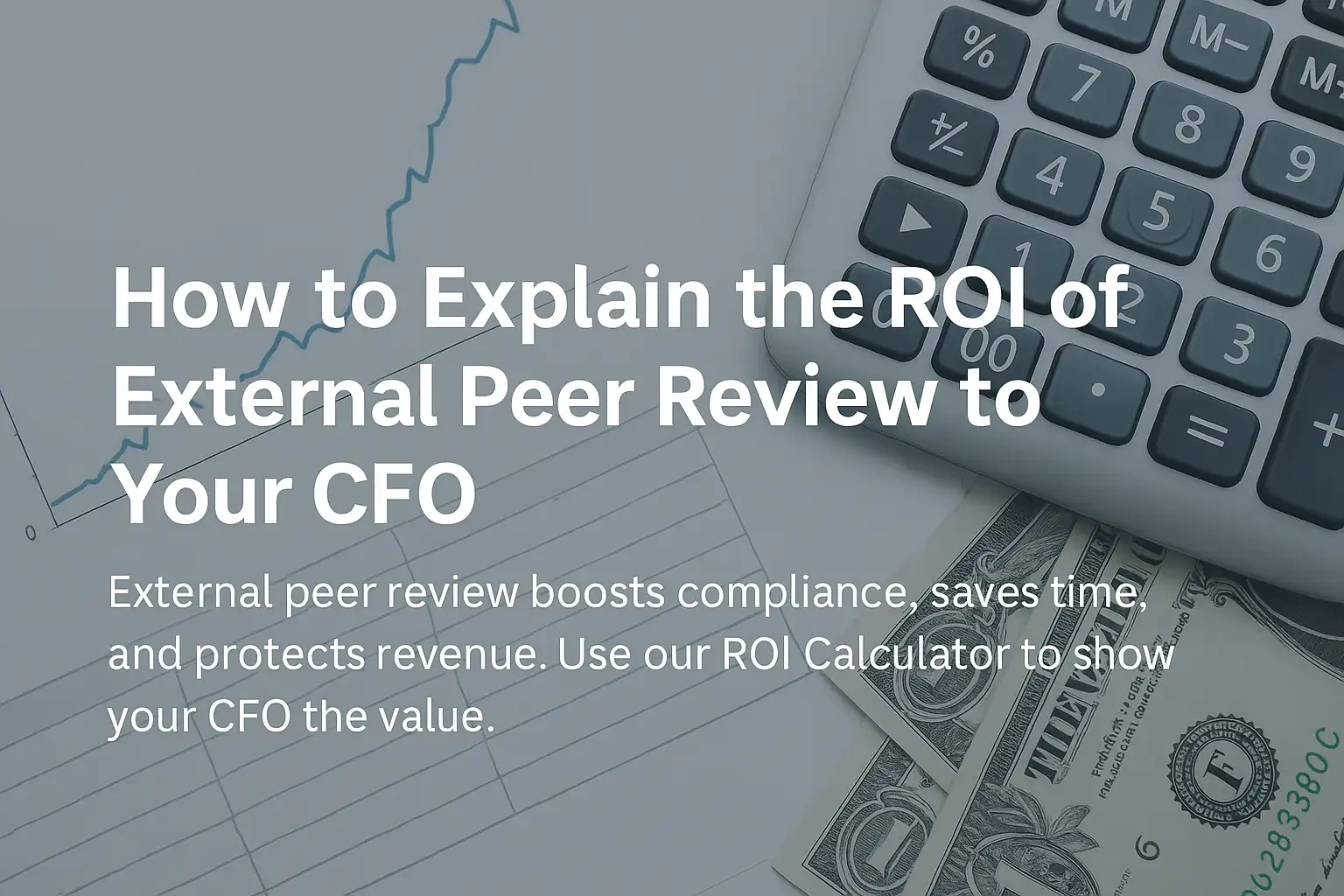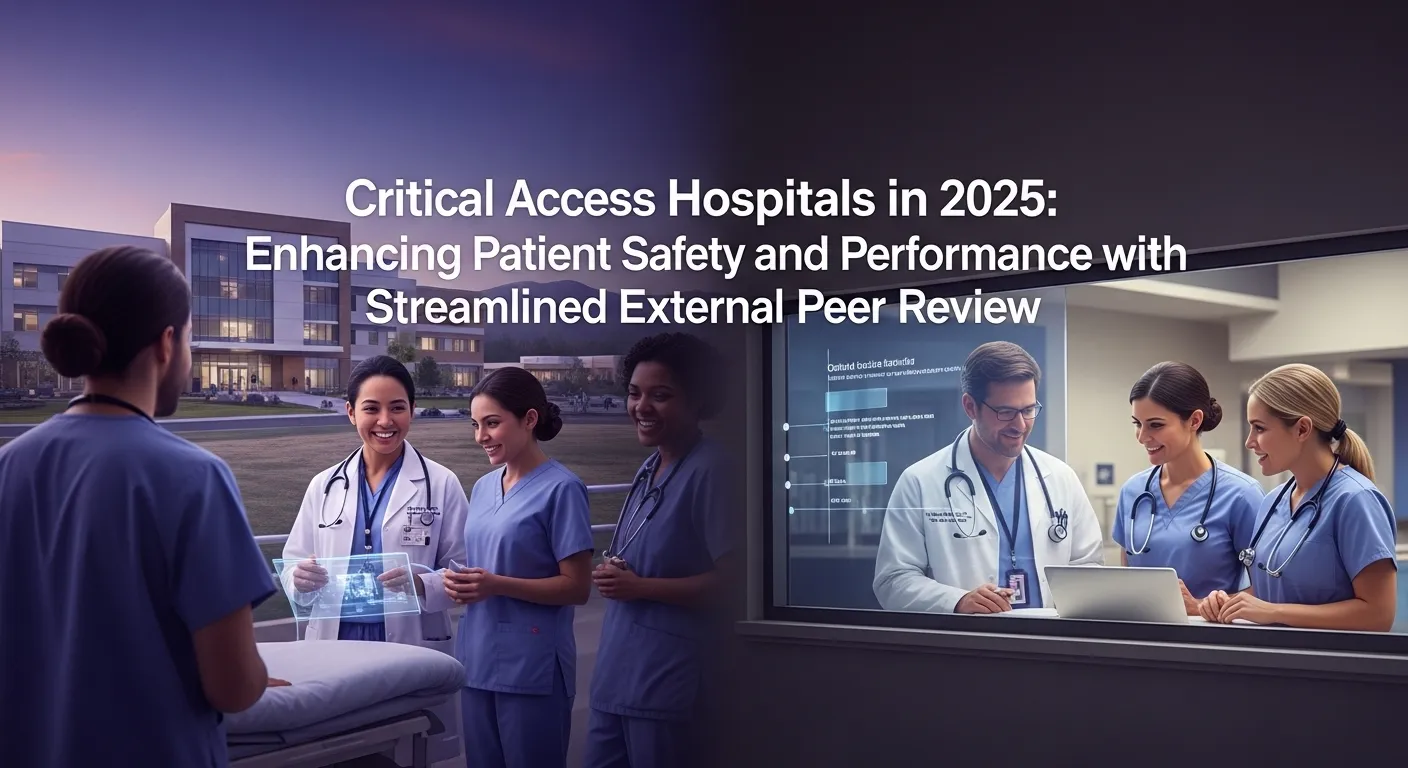

How to Explain the ROI of External Peer Review to Your CFO
External peer review boosts compliance, saves time, and protects revenue. Use our ROI Calculator to show your CFO the value.
When your healthcare organization is asked to justify every dollar spent, even quality improvement programs—like peer review—face scrutiny. This is especially true at Federally Qualified Health Centers (FQHCs) and Critical Access Hospitals (CAHs), where margins are razor-thin and the CFO’s job is to ensure sustainability.
But what if peer review didn’t just satisfy compliance and patient safety obligations—but actually paid for itself?
That’s the argument many Quality Directors and CMOs are beginning to make. And with the right framing—and tools like a Peer Review ROI Calculator—you can make a compelling business case that resonates with your CFO.
Let’s break it down.
📌 The Problem with Internal Peer Review Overhead
Internal peer review might seem like the cheaper route. After all, you already pay your providers, so assigning them peer review responsibilities adds no direct line item.
Except it does.
- Provider Time ≠ Free
Every hour a physician spends reviewing charts is an hour not spent on patient visits. And in high-volume specialties like family medicine or OB-GYN, that lost productivity can add up fast. - Admin Chaos
Internal peer review often requires coordination, chasing providers for overdue reviews, and inconsistent review quality depending on who is assigned. This results in unnecessary staff time, follow-ups, and rework. - Inconsistent Compliance
Many organizations find that despite best efforts, they still have missing reviews when HRSA or accreditation bodies audit them. That’s not just a headache—it’s a risk.
💡 How External Peer Review Saves Money and Time
An external peer review program offers predictable costs and measurable value. Here’s how:
1. Reduces Internal Labor Costs
Instead of using highly paid clinical staff for reviews, external reviews shift the labor to independent experts—often at a lower effective hourly cost than an in-house MD.
2. Protects Revenue-Generating Activity
By outsourcing, your employed providers spend more time with patients, generating revenue and reducing the risk of burnout from administrative overload.
3. Ensures Timely Completion
With external reviewers, you eliminate the gap between “assigned” and “done.” Reviews are completed on time—no chasing, no reminders, and no stress when site visits come around.
4. Improves Legal Defensibility and Reduces Risk
Objective, third-party peer reviews create a stronger line of defense in the event of litigation. They demonstrate proactive quality efforts and eliminate perceived internal bias.
5. Strengthens Compliance Position
HRSA, The Joint Commission, and other accrediting bodies increasingly expect structured, consistent review processes. External reviewers ensure you're using appropriately licensed professionals and relevant subspecialists—a detail often overlooked with internal reviews.
🧠 How to Frame the ROI Conversation with Finance
When presenting to your CFO, stick to a few key ideas:
✅ Focus on cost avoidance, not just cost
Think in terms of risk mitigation, not just line items. One malpractice lawsuit avoided—or one HRSA site visit without corrective actions—can justify years of review spending.
✅ Emphasize efficiency gains
Demonstrate how outsourcing allows you to standardize processes, reduce delays, and ensure clinical staff focus on what they do best: delivering care.
✅ Use concrete numbers
Don’t guess. Use tools like the Peer Review Calculator below to estimate potential savings from recovered provider time, reduced admin overhead, and avoided risks.
✅ Align with strategic goals
Quality, compliance, risk mitigation—these are all high on the CFO’s radar. Show how external peer review supports each of these without ballooning costs.
🔄 A Hybrid Model Still Works
If you're not ready to go 100% external, no problem. A hybrid model allows you to:
- Keep internal reviewers engaged while using external support for high-risk specialties
- Use external reviews as quality checks to validate your internal process
- Supplement internal reviews during times of staff turnover or high workload
This gives you the best of both worlds: cost control and quality assurance.
💬 Final Thought
CFOs aren’t looking for more expenses—they’re looking for value. When done right, external peer review isn’t a cost center. It’s an investment in:
- Staff efficiency
- Regulatory compliance
- Patient safety
- Financial sustainability
And best of all, it’s measurable.
Use the Peer Review ROI Calculator below to build your own cost-benefit case and start the conversation today.

Critical Access Hospitals in 2025: Enhancing Patient Safety and Performance with Streamlined External Peer Review
CAHs face unique peer review challenges. External services like Medplace offer objective expertise, streamline compliance, and boost patient safety, provider satisfaction, and grant competitiveness.
.png)
.png)

The New Era of Telehealth: Ensuring Quality and Compliance in Rural Virtual Care Through External Peer Review
External peer review is vital for ensuring quality and compliance in rural telehealth. It mitigates bias, fills specialty gaps, reduces administrative burden, and strengthens compliance for FQHCs and CAHs.
.png)
.png)

Mitigating Risk in Tribal Health: Proactive Patient Safety with Culturally Competent External Peer Review
External peer review offers Tribal Health Organizations unbiased, culturally competent assessments, reducing administrative burden, improving patient safety, and strengthening compliance documentation.
.png)
.png)



.png)
.png)
.png)


.png)




.png)